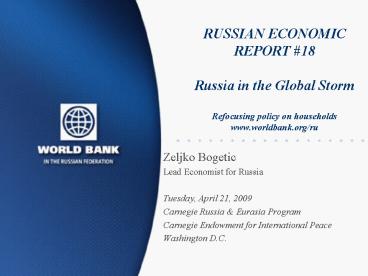RUSSIAN ECONOMIC REPORT - PowerPoint PPT Presentation
1 / 31
Title:
RUSSIAN ECONOMIC REPORT
Description:
Demand sources of Russia's growth (in percent) ... III. RUSSIA'S FISCAL POLICY RESPONSE initially ... DOWNSIDE RISKS FOR THE WORLD ECONOMY AND RUSSIA REMAIN ... – PowerPoint PPT presentation
Number of Views:41
Avg rating:3.0/5.0
Title: RUSSIAN ECONOMIC REPORT
1
RUSSIAN ECONOMIC REPORT 18Russia in the
Global Storm Refocusing policy on
householdswww.worldbank.org/ru
- Zeljko Bogetic
- Lead Economist for Russia
- Tuesday, April 21, 2009
- Carnegie Russia Eurasia Program
- Carnegie Endowment for International Peace
- Washington D.C.
2
- The global storm
- Russias storm
- Policy response
- What more can be done?
3
I. The worst global crisis since WWII
- Deep, synchronized, global crisis with financial
crisis
4
Global Economic Outlook for 2009-10 Grim
- Real GDP growth
- -1.7 (2009)
- 2.3 (2010) (highly uncertain)
- World trade
- -6.1 (2009)
- 3.9 (2010) (highly uncertain)
- Oil prices
- USD 47.8 (2009) Urals 45
- USD 52.7 (2010) Urals 45 -48
5
Capital flows to developing countries drying out,
oil prices to remain low
6
II. RUSSIAS STORM TRIPLE WHAMMY
- Before the storm economy overheating
- Oil from 140 to 40 per barrel
- Capital from 80bln (07) to -130 (08)
- Financing sharp drop, high spreads
7
INTO THE STORM Stock market, financial sector
liquidity crunch, growth, industrial production
collapse
8
Demand sources of Russias growth (in percent)
9
Across-the-board slowdown, then deep recession in
ealry 2009
- Both tradable and non-tradable sectors hit
- Dramatic drops in early 2009.
- Construction -18.8 (Jan-Feb)
- Transport -18.2 (Jan-Feb)
- Retail trade -2.4 (Feb)
- Manufacturing -18.3 (Feb)
10
Why was the impact on Russia so strong?
- Dependence on
- Oil, gas and metals
- Capital inflows, and
- Short-term external borrowing by banks and
enterprises - Small SME sector
- Narrow economic structure and low value added
- Low competitiveness
- Unexpectedly deep drop in world demand
11
Labor marketsadjusting rapidly
12
Employment changes in tradable and non-tradables
13
Balance of paymentsweakening due to massive
terms of trade shock and capital outflows
- Current account balance
- 98 billion (year 08)
- 8 billion in q4 08
- Capital account balance
- 82 billion in 07
- -130 billion in 08
14
Many Russian banks were relying excessively on
foreign borrowing
15
Monetary-Exchange and Fiscal policyaiming to
limit the impact of the crisis
- Monetary-exchange policy
- Initially supporting liquidity
- Now supporting ruble, preserving reserves
- Fiscal policy
- Fiscal support to banks and enterprises
16
Outlook for Russia, 2009-10
17
Fraternal twins Russias two crises 1997-98 and
2008-09
18
III. RUSSIAS FISCAL POLICY RESPONSEinitially
supporting banks and enterprises
- Total fiscal support 2008-09 ( GDP)
- Total 6.7
- Financial sector 3.3
- Real economy 2.5
- Social protection 0.2
- Regional transfers 0.7
- Source World Bank staff estimates, Russian
Economic Report No. 18.
19
Support to the financial system
- Total support to fin sector 2008-09 ( GDP)
- Total 3.3
- Subordinated loans 2.3
- Recapitalization 1.0
20
Supporting the real economyusing direct support
and easing the tax burden
- Total fiscal stimulus in 2008-09 ( GDP)
- Total 3.4
- enterprises 2.4
- households 0.4
- Regions 0.6
21
Some features of fiscal support to enterprises
- Emphasis on tax reduction
- Limited infrastructure spending
- Limited support to SMEs
- Limited interventions in the labor market
- Potential support to strategic enterprises
22
How does Russias fiscal stimulus compare with
G-20 countries?
23
Social impactspreading fast
24
Projected amount of poor people before and after
the crisis (in millions), 2008-09
25
What more can be done?
- Targeting households, infrastructure, and small
and medium enterprises - Additional social package must be
- Affordable
- Cost efficient in alleviating poverty
- Scaleable
- Using exisiting SSN mechanisms
26
The additional social package is constructed so
as to maximize impact on poverty
27
PROPOSED PACKAGE
28
What more?
- IN SUM, we propose in the short-term
- Social protection package (1 of GDP)
- Infrastructure and SMEs (0.5 of GDP)
- And
29
Back to the future Accelerating structural
reforms
- Banking sector modernization
- Public administration and governance reform
- Improving investment climate
- Infrastructure
- WTO agenda
- Improving effectiveness and targeting of the
safety net
30
DOWNSIDE RISKS FOR THE WORLD ECONOMY AND RUSSIA
REMAIN
- Social impact and associated social tensions
- Second round effect on financial sector
- Prolonged depression of global demand
- Therefore, policy must remain vigilant, flexible
and ready to respond quickly to changing
conditions. - In a downside scenario, well designed and
implemented public works programs may be needed.
31
Thank you!

